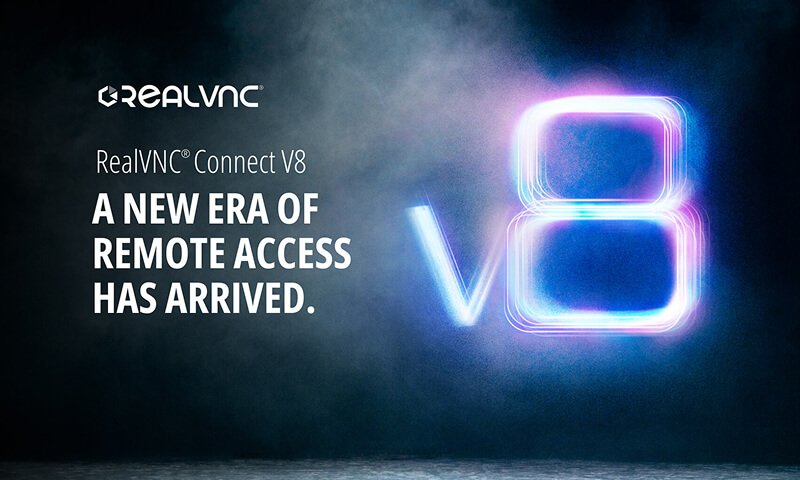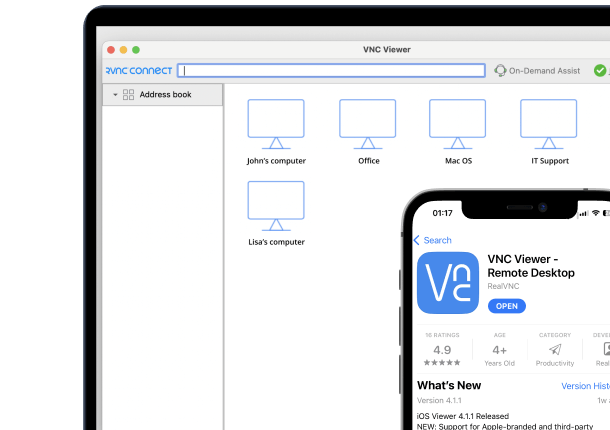What if students could take a trip to another galaxy without leaving their desks? Or explore the human body without having to reach for a scalpel? That’s the promise of augmented reality in education, a fast-growing approach that brings digital content into the real world and gives lessons a whole new dimension.
AR technology isn’t a gimmick, nor is it a passing trend. It’s already reshaping the learning experience in classrooms by making topics that are hard to grasp feel intuitive and enjoyable. Whether students learn best by seeing, hearing, or doing, AR offers something for different learning styles.
In this article, we’re going to explore how AR is being used today across subjects. We’ll also take a look at which tools and strategies make it work, what challenges schools need to prepare for, and how secure remote access like RealVNC Connect is helping support the shift.
What Is Augmented Reality and How It’s Used in Educational Settings
Imagine geography lessons where students don’t just read about fault lines but watch them shift beneath the classroom. Or where the solar system spins like clockwork above their desks. That’s precisely the kind of experience augmented reality brings to modern educational settings.
Augmented reality adds digital content like animations, sound, or virtual objects to the real-world environment students are already in. It doesn’t replace the classroom. It actually enhances it. Compared to virtual reality, which creates a fully immersive digital world, AR keeps students grounded while overlaying digital content of context-rich, interactive “augmented” layers on top of reality.
How AR Tools Work in Practice
AR tools use devices most schools already have access to:
- Tablets
- Smartphones
- Laptops with webcams
- In some cases, mobile AR headsets
These tools can display virtual elements over physical surfaces. In astronomy, for example, AR enables students to hold their GPS-enabled smartphones to the night sky and see the labels of stars, planetary bodies, and constellations.
As Jamie Donally of ARVRinEDU puts it, AR lets students “experience it personally.” It’s a far cry from just flipping pages, reading Wikipedia, or watching videos.
With no need for expensive VR headsets and controllers, schools with limited IT resources can benefit from AR. Teachers and support staff can remotely guide setup, monitor devices, or troubleshoot AR apps using secure remote access. One way technology like RealVNC Connect is helping to bridge the gap between knowledge and accessibility in education.
Essentially, overlaying digital content onto familiar environments means AR makes learning tactile, interactive, and most importantly, memorable.
Why Augmented Reality Tools Improve the Learning Environment
When you were at school, did some lessons just “stick better” because you could actually see them in action? Augmented reality tools help foster that “stick.” AR helps students engage with abstract concepts in real-time. For primary school classrooms, high school STEM labs, or even corporate professional training sessions, AR helps bring theory and understanding together.
AR boosts student engagement by offering interactive 3D models, simulations, and guided experiences that feel more like exploration than instruction. Plenty of current research supports this. McGraw Hill’s survey of teachers showed 86% say AR has improved student engagement, and 72% noticed higher student motivation. It isn’t just anecdotal, either. Students using AR have been shown to remember 40% more content compared to traditional methods.
Beyond participation, AR supports a wide range of learning styles. Visual learners get to benefit from detailed models, auditory learners from narration, and hands-on learners from tapping and interaction. This flexibility leads to stronger learning outcomes, including better test performance. In math-focused studies, AR users consistently outperformed control groups in comprehension and retention.
Other key benefits include:
- Reduced extraneous cognitive load, allowing students to focus on what matters.
- Improve critical thinking through interactive, challenge-based learning.
- Increase accuracy and confidence, especially in subjects involving complex concepts.
AR creates a more immersive learning experience for students. It strengthens their connection with the material and their retention of it.
AR Applications Across Subjects: Bringing Lessons to Life
One of the more exciting things about AR technology is its flexibility. Whether students are deciphering equations, walking through history, or visualizing the circulatory system, AR applications bring a far more immersive learning experience to nearly every subject imaginable.
Science and STEM: Making Complex Concepts Tangible
In science classes, AR transforms the invisible into the visible. Students can manipulate molecules, simulate chemical reactions, or explore our solar system without needing lab space or a SpaceX rocket. In physics, AR simulations demonstrate motion, gravity, and magnetism using interactive visuals layered into the real environment.
Biology and Health: Exploring the Human Body
Dissecting a frog on a tablet doesn’t smell the same, but it’s far less messy (and traumatic). In biology and health education, students use AR apps like Visible Body to explore the human body in layers by zooming in on organs, vessels, and systems. This hands-on visual experience improves spatial reasoning and supports skill development in medical and health pathways.
History and Geography: Stepping Into the Past
Apps like GeoGeek AR make geography lessons more than just a map of countries and cities. With AR sandboxes, students can explore topography, landmarks, and hydrological systems as if they were happening in the room.
When it comes to history, apps like 3DQR’s AR locations let students walk around historical sites and witness re-creations of the original structures from their smartphones and tablets via location-based AR.
Math and the Arts: Visual Thinking and Creativity
In math, AR can help students visualize formulas and mathematical concepts like calculus curves and geometric transformations. For preK-3 students, apps like Math Alive use a computer with a camera and a set of cards to practice counting and basic numeracy. Meanwhile, art students can use platforms like Artivive to scan their works and bring them to life, and readers can use AR books to experience them in a whole new way.
In classrooms, AR equipment can be set up as a dedicated space called an “AR station.” These AR stations usually consist of a PC , laptop, or tablet that runs AR content through apps and connected hardware. While the AR headsets themselves are not remotely accessible, the computers or mobile devices powering them often are.
RealVNC Connect gives IT teams and educators secure, remote access to these core devices, regardless of which operating system they’re running. This makes it easier to monitor usage, push updates, transfer files, and troubleshoot issues across classrooms or even entire campuses. All without needing to be physically present.
For a closer look at how secure remote access supports digital learning environments, download our free eBook on complete remote access solutions for the education industry. There, you’ll find practical ways to simplify device access and scale support.
Implementing Augmented Reality in the Classroom: What to Plan For
Using augmented reality in schools opens doors to more engaging, hands-on learning. However, it works best when grounded in clear goals and practical planning.
Before choosing AR tools or platforms, educators should start with their learning objectives. Is the goal to boost comprehension in science? Encourage collaboration in social studies? Or is it to build visualization skills in math?
Knowing the “why” helps determine the “how.”
Once objectives are clear, the logistical side begins. Educators and IT staff need to assess the following:
- Device compatibility, especially across different brands or operating systems.
- Remote and mobile device management (MDM) and access policies.
- Charging and battery life expectations.
- Wi-Fi strength and classroom connectivity.
- Teacher confidence and training in AR-specific instructional strategies.
Additionally, privacy and security cannot be treated like an afterthought. Many AR platforms rely on cloud storage and real-time user data. Schools should look for platforms that comply with privacy laws such as FERPA, COPPA, and GDPR. EdTech Magazine and IT experts say that schools can be held liable for a breach if not compliant.
RealVNC Connect supports this by providing secure remote access to the computers and tablets that run or manage AR content. With features like enterprise-grade security, end-to-end encryption (e2ee) and granular access control, IT teams can remotely update software, load lesson files, and troubleshoot issues on the devices that power the AR experience.
How AR Technology Supports Remote and Hybrid Learning
Augmented reality is no longer limited to the physical classroom. In remote education and hybrid models, it creates immersive digital experiences for students regardless of where they are. With mobile learning and cloud-based AR simulations, students can:
- Interact with digital content like 3D models and historical environments.
- Collaborate on science labs or group projects inside shared virtual spaces.
- Experience interactive learning from the comfort of your home using just a smartphone or tablet.
Behind the scenes, this model relies on stable access to the devices and systems that run AR tools. While the AR content itself may live in the cloud or on local apps, IT teams still need a way to manage the computers and tablets that power these experiences
RealVNC Connect helps by providing secure remote access to those devices. This allows IT staff to:
- Troubleshoot technical issues for students or teachers during live sessions
- Install or update AR software on school-owned laptops or tablets
- Support teacher training sessions without requiring in-person setup
- Transfer lesson materials or AR content files before or during class
This kind of secure access software for education helps keep hybrid and remote AR learning running smoothly without interrupting the lesson.
Choosing the Right AR Tools: From AR Apps to Full Platforms
There’s no universal approach to choosing augmented reality tools for your school. Some classrooms need a lightweight app for mobile devices, while others might be ready for advanced setups that can support full-scale simulations.
The best choice depends on your goals, budget, and how much IT support your school can provide.
Below, we’ve made a comparison chart of the most widely used AR platforms, showing how each fits into different educational settings:
| Platform | Description | Accessibility | Cost | Compatibility |
| Delightex VR and AR | Build and explore interactive 3D environments in the classroom. | High | Low | Cross-platform |
| Merge EDU | Hands-on AR learning using physical cubes and mobile devices. | High | Low to Medium | Mobile-focused |
| Zapper AR and XR | Browser-based and mobile AR platform for creating and viewing interactive media. | High | Low to Medium | Browser and Mobile (iOS and Android) |
| Microsoft HoloLens 2 | A dedicated mixed-reality headset for advanced AR simulation and training. | Moderate to Low (requires proprietary hardware) | High | Windows-only |
For many schools, it’s best to begin with lower-cost options and expand as confidence and technical capacity grow. Testing and deploying AR apps across different devices and operating systems is more streamlined with a remote access solution that supports cross-platform access.
RealVNC Connect provides a standardized remote access experience across Linux, Windows, macOS, iOS, and Android.
How to Measure Impact and Make Augmented Reality Worth the Investment
Evaluation of the value of augmented reality starts with the right tracking metrics. These indicators help schools understand whether AR is improving outcomes or just adding yet another layer of complexity:
- Test score improvements: Track the before-and-after performance.
- Time to mastery: Measure how quickly students can grasp new material.
- Student participation rates: Compared engagement with and without Augmented Reality.
- Knowledge retention: Assess how well students recall material over time.
- Teacher workload: Identify reductions in repeated explanations or prep time.
Beyond academic results, there’s also operational ROI to consider. RealVNC Connect supports IT teams by enabling remote classroom management, fast troubleshooting, and content deployment.
Conclusion: A Smarter Immersive Learning Experience
Introducing augmented reality in education is a practical way to deepen understanding, engage students, create more dynamic classrooms, and have fun while doing it. From visualizing complex ideas to supporting various learning styles, augmented reality helps educators deliver lessons that actually stick.
To support AR across physical and remote settings, try RealVNC Connect. It’s a secure and scalable way to manage classroom technology. Download RealVNC Connect to get started and see how simple and powerful remote access can be.
Curious about what’s next? Check out our Future of Education whitepaper for more insights into where education is heading next.
Frequently Asked Questions
How can teachers integrate augmented reality into daily lessons?
Start with clear teaching methods and goals, then choose AR tools that align. Simple mobile apps make it much easier to test ideas without overhauling your entire curriculum.
What types of educational content work best with augmented reality?
AR is especially effective for science, history, and math. Basically, any subject where students need to visualize abstract concepts or explore spatial relationships.
Does augmented reality actually help students more than traditional approaches?
Yes. By combining computer-generated graphics with hands-on interaction, AR increases participation, especially for visual and kinesthetic learners.
Can augmented reality really revolutionize education, or is it just hype?
When incorporated well, AR is more than just hype. It delivers digital information in context, encourages exploration, and supports integrating AR into long-term instructional strategies.







